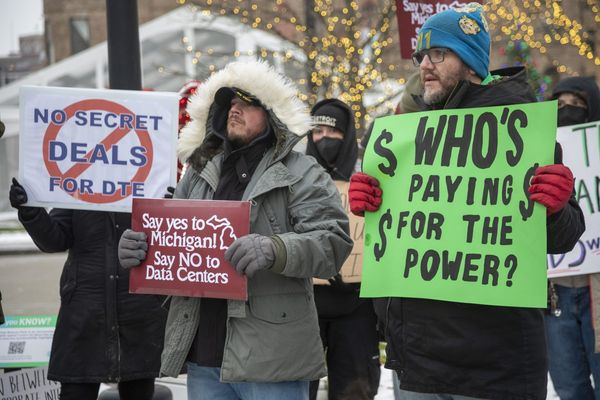
On Tuesday 20 May, as rain pounded Taree and flood waters rose, eight people wheeled a grand piano on its castors across one of the town’s main streets and into an office block.
The piano, worth $20,000, was saved and still sits in the office nearly two weeks later, with employees working around it.
But much of the rest of the stock from Bass ‘N’ Blues Music Megastore – including 180 guitars, 80 amplifiers and $100,000 worth of sheet music – was destroyed.
“We went through the floods four years ago and we’ve been putting it back together ever since,” Tanya Brown says. “But we did a shop change a few weeks ago and it’s the best it’s ever looked.
“We got new guitar lines in just days before the flood. A $6,000 amplifier I’ve been waiting on for nine months for a customer, that arrived a couple of days before – it’s gone.”
Brown, 51, who has lived in Taree all her life, says the hardest moment was walking back into the store the first time after the flood waters that hit the mid-north coast of New South Wales had receded.
“There were tears for about 20 minutes and we thought, we’ll let ourselves have that moment, then we put our boots on and got to work.”
Brown, her husband, Trevor, with whom she runs the store, friends and a crew of volunteers who were waiting outside the shop ready to help clean it up have emptied the place and got it ready for reconstruction: gyprock walls need pulling out, carpets need replacing.
“Once we’ve done that we can get some stock back in and start getting it back together,” she says. Reopening is her primary focus, for her staff and for the town. “Our community needs us, we’re a driver of musical education and live music playing – we need to get back up and going.”
On the one hand, Brown is testament to the resilience of survivors of disasters that politicians rightly praise as they tour waterlogged or fire-ravaged towns.
But she has questions too, questions that move beyond immediate recovery for her store and Taree, and shift the focus from individual – or even community – responsibility for recovery. Questions about how we handle crises like these in future, the perils of insurance in increasingly uninsurable communities, how governments support people in the wake of disasters, and whether bigger conversations around disaster adaptation and mitigation need to happen.
“We’ve really been dealing with these massive events these last few years,” Brown says. “It seems to take governments a long time to be able to initiate those conversations and change.
“Whatever’s changing our climate – they can argue about what it is until the cows come home – but the fact is it’s changing and we’re going to have to do things differently.”
‘A red flag for flood insurance’
The most immediate question for many people following the frantic drumbeat of disasters across Australia is what to do about insurance.
Floods that hit the mid-north coast and Hunter region in 2021 rendered nearly 1,200 houses uninhabitable – including one that was found drifting in the Manning River – and led to more than 53,144 insurance claims totalling $629.6m.
In the wake of that disaster, many home and business owners found their properties suddenly uninsurable for flood damage. Others were faced with premiums costing tens of thousands more each year.
Brown was one of the lucky ones – if anyone whose business has just been destroyed and community pulverised by a natural disaster can be described as lucky – in that she had flood insurance. But she does not anticipate that getting a payout will be straightforward.
Her insurance payout from 2021 – about $350,000 – came through four months ago. She describes getting it as “the fight of our lives”.
This time, three times the volume of water came into her store, the damage was far worse, and the claim could be twice as high. She anticipates another battle.
Rupesh Phirangi is the owner of Manning Valley Dental, which sits right on the riverfront, with sweeping views from its veranda and bay windows of the beautiful Manning River. He had flood insurance until the 2021 floods. After that, he suddenly found no company would offer him flood insurance.
“The problem is we have been given a red flag for flood insurance,” he says. “The maximum we could take is storm damage.”
In Phirangi’s 20 years in the area, the flood waters only ever filled his surgery’s garage on the lower level, never getting beyond the doorstep of the clinic on the first floor.
But this time – his first flood uninsured – the water was waist-high in the clinic.
He estimates 80% of his equipment – much of it electrical, expensive and specialised – has been destroyed, leaving him with a bill of $250,000-$300,000.
“It has done a massive devastation,” he says. “Unimaginable.”
Without insurance, it isn’t clear how Phirangi will be able to rebuild and get his business running again.
Various state and federal government grants exist to help people who are uninsured. The NSW premier, Chris Minns, said on a visit to the area on Thursday he had had “extensive talks” with the prime minister about support for businesses and primary producers.
As of Friday, the details of the package had not been announced, with Minns saying they would be made public “imminently”.
“We want to make sure that the assistance … works, pulls those businesses back out of a very difficult situation and ensures that they continue to operate,” the premier said on Thursday.
Phirangi says: “We have been told there will be some sort of funding available. But this is a big loss, I’m not sure to what extent they will help us.”
Ian Wright, an associate professor in environmental science at Western Sydney University specialising in water management and policy, says the situation facing communities in flood-prone or bushfire-prone areas shows “the insurance system has broken down”.
“I think there’s a question about the social licence to operate of insurers at the moment. And I think that’s really, really, really deep, and I think it’s going to hit other disaster-hit communities as well: coastal flooding, bushfire, floods.”
Wright says a new model has to be considered, suggesting that the federal government could implement an underwriting agreement with insurers for flood disasters, in the same way it does for cyclone-hit communities.
“I don’t know why we wouldn’t adopt that. But it seems half-hearted, very petty, and we really haven’t got our heads around collectively how we support these communities and step in to provide very significant help to those who are uninsured.”
Greg Mullins, the former NSW Fire and Rescue commissioner and founder of Emergency Leaders for Climate Action (Elca), says insurance companies pulling out of providing coverage for disaster-prone areas cop a lot of criticism but are often just following the business case.
“People don’t realise, but insurers have to price to the risk, and … they’re sometimes better at risk assessment than governments are.
“People like to blame them. But why would you give away money if you’re in a business?
“I’m not an apologist for the insurance industry, but it’s just maths.”
There is just not enough money in the government coffers to make up the shortfall, he says.
“There’s too many people needing that government help, now that there’s so many uninsured. Everything we’re talking about is billions and billions of dollars.”
Mullins’ solution would be a tax on super profits of fossil fuel companies. “Let’s tax them properly and set up a national climate adaptation and resilience fund.”
Can he imagine there ever being political will for such a policy?
“I hope so. I hope [Labor] have got the guts with this massive mandate for change, and the proof will be in the pudding when people can actually be moved – you know, have their homes moved out of harm’s way, have a new home built, do it with dignity. They’ll think, ‘Wow, what a great idea.’”
‘You worry about the next one’
The question of moving is a fraught one and not one that Jenny Wilkinson, 77, had considered until last week’s flood.
She lives with her partner George on a two-hectare property on the edge of Taree that her parents bought in 1978. It’s a property she loves dearly, describing the huge fig trees lining the drive that were planted by her father four decades ago. They probably protected the home from some damage when the flood waters rose, the giant branches catching wood and debris that could have smashed their house.
George, who is in his late 80s, has serious health problems that prevented the couple from leaving their property in a timely way and so they had to be rescued, clambering over an upstairs veranda and into a police boat.
When she returned to the property, she found the body of one of her three pet horses, a Shetland pony, by the house. They lost all their horses, most of their 20 cattle and all but one chicken.
Inside the house, the ground floor was filled with mud and furniture had been ruined, but the biggest blow was the photographs. “Mum and dad’s photos that were up on the walls, the real old ones with the curved glass, they’re all gone. So the memories you’ve got in your head, but you can’t look at them and say, ‘Hi Mum, hi Dad’.”
Wilkinson doesn’t have insurance. After the 2021 floods, when a metre of water entered her home and much of the contents were destroyed, only one company would offer her flood insurance. The premium they were asking exceeded the amount she got for her pension each year and so she couldn’t take it up.
She has had a lot of community and family help clearing the property, and is staying with her sister in town until the home is habitable again, but isn’t sure whether she could stay there for the long term.
After the devastating northern rivers floods of 2022, the NSW government instituted a scheme to buy properties in areas at risk of flooding, giving owners the option to move that home to a new location in some cases.
Wright says we may have reached the point where we need to start talking about moving people – and even whole communities – off flood plains. These are big and challenging conversations, he acknowledges.
“We are so far from knowing how to respond in a collective sense. I think we’re suffering policy failure in this area. And again, looking at somewhere like Lismore and … our inability handle that on what in Australia really should be a manageable scale, to help a vulnerable community like that. I don’t think it bodes well for the recovery of the people of the Manning.”
Asked whether she would consider accepting a buyback if the government were to institute such a program in Taree, Wilkinson is initially emphatic.
“I’d never move. Even if they paid me to move, I wouldn’t move.”
But then she stops for a moment. “Maybe I might reconsider that, not moving. After all, it depends how much they offer, I guess, so you can set up somewhere else. Yeah, I guess I might reconsider it. I have to give that a bit of thought. I love it out here, but sometimes, as we’re getting so old, maybe it’s a good thing that we do move.
“You worry about the next one, don’t you?”







